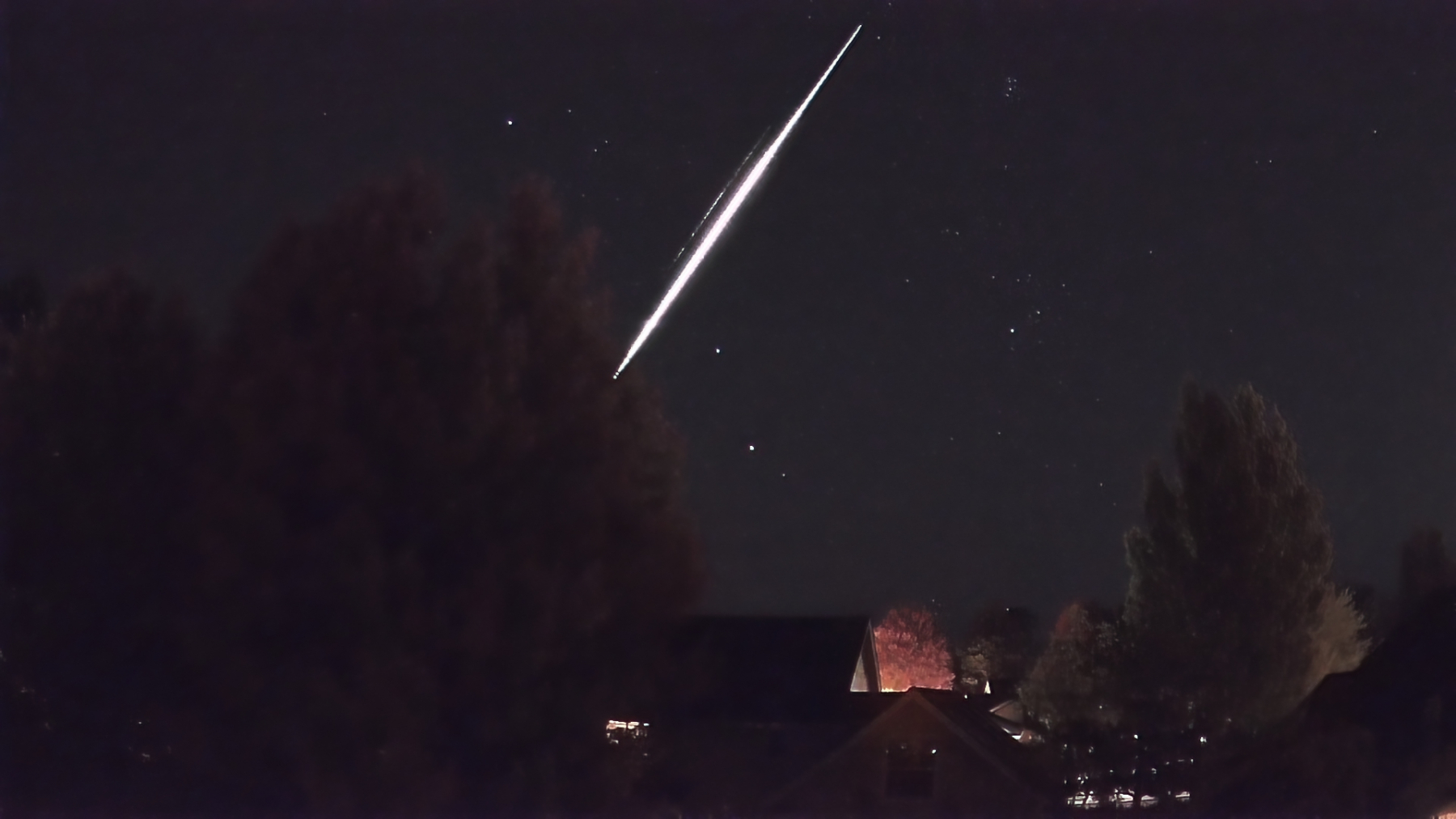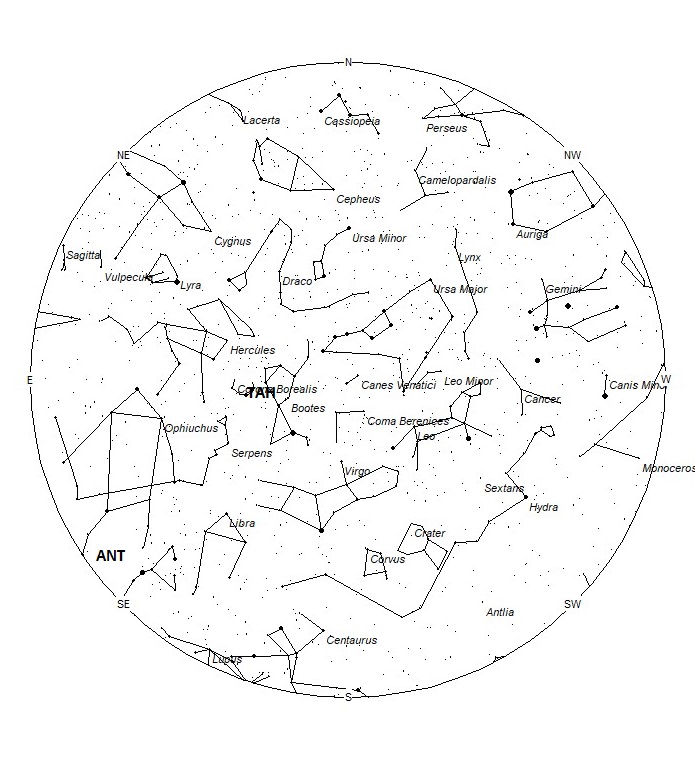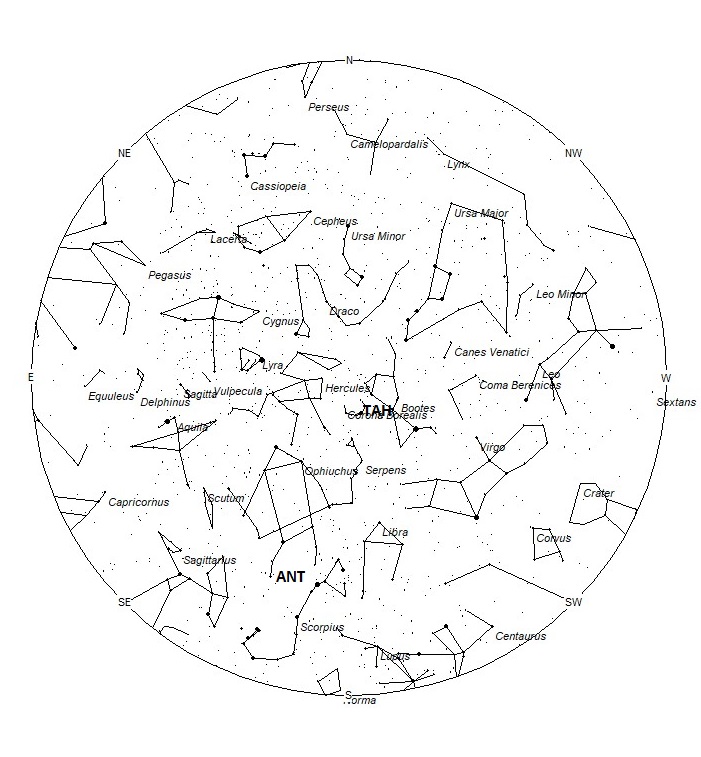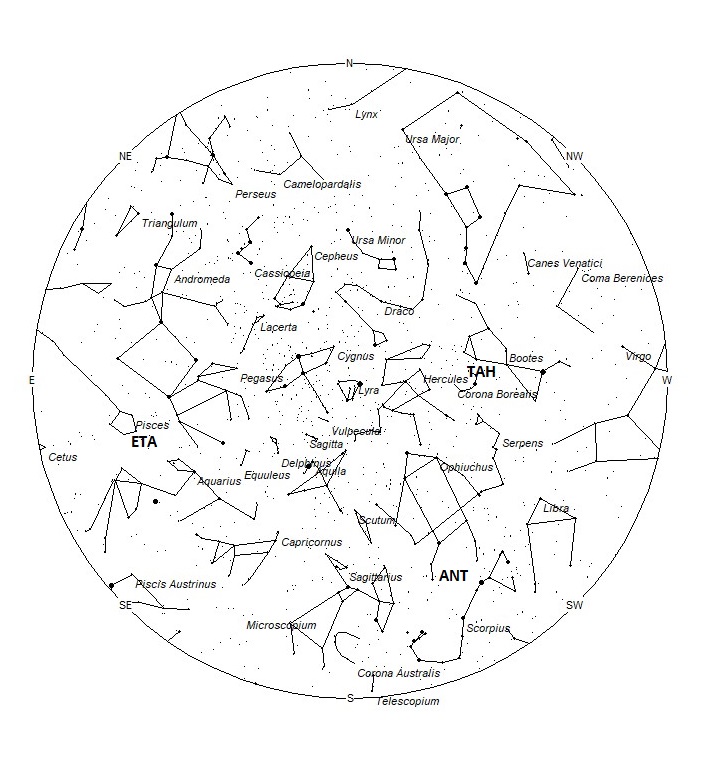 Jordan Ragsdale captured this Southern Taurid fireball using his AllSky Camera System on October 23, 2022, at 23:04 MDT (5:04 UT on October 24) from Eagle, Idaho, USA. The fainter trail above the fireball is a camera artifact. For more information on this event visit: https://ams.imo.net/members/imo_view/event/2022/7287 ©Jordan Ragsdale
Jordan Ragsdale captured this Southern Taurid fireball using his AllSky Camera System on October 23, 2022, at 23:04 MDT (5:04 UT on October 24) from Eagle, Idaho, USA. The fainter trail above the fireball is a camera artifact. For more information on this event visit: https://ams.imo.net/members/imo_view/event/2022/7287 ©Jordan RagsdaleDuring this period, the moon waxes from a slim crescent to nearly one-half illuminated by the end of the week. Only toward the end of this period will it begin to interfere with meteor observing as it enters the morning sky. This weekend a very skinny crescent moon sets near the end of dusk and will not interfere with meteor observing. The estimated total hourly rates for evening observers this week should be near 3 as seen from mid-northern latitudes (45N) and 4 as seen from tropical southern locations (25S) For morning observers, the estimated total hourly rates should be near 8 as seen from mid-northern latitudes (45N) and 15 as seen from tropical southern locations (25S). The actual rates seen will also depend on factors such as personal light and motion perception, local weather conditions, alertness, and experience in watching meteor activity. Note that the hourly rates listed below are estimates as viewed from dark sky sites away from urban light sources. Observers viewing from urban areas will see less activity as only the brighter meteors will be visible from such locations.
The radiant (the area of the sky where meteors appear to shoot from) positions and rates listed below are exact for Saturday night/Sunday morning May 20/21. These positions do not change greatly day to day so the listed coordinates may be used during this entire period. Most star atlases (available at science stores and planetariums) will provide maps with grid lines of the celestial coordinates so that you may find out exactly where these positions are located in the sky. I have also included charts of the sky that display the radiant positions for evening, midnight, and morning. The center of each chart is the sky directly overhead at the appropriate hour. These charts are oriented for facing south but can be used for any direction by rotating the charts to the desired direction. A planisphere or computer planetarium program is also useful in showing the sky at any time of night on any date of the year. Activity from each radiant is best seen when it is positioned highest in the sky, either due north or south along the meridian, depending on your latitude. It must be remembered that meteor activity is rarely seen at its radiant position. Rather they shoot outwards from the radiant, so it is best to center your field of view so that the radiant lies at the edge and not the center. Viewing there will allow you to easily trace the path of each meteor back to the radiant (if it is a shower member) or in another direction if it is sporadic. Meteor activity is not seen from radiants that are located far below the horizon. The positions below are listed in a west to east manner in order of right ascension (celestial longitude). The positions listed first are located further west therefore are accessible earlier in the night while those listed further down the list rise later in the night.
These sources of meteoric activity are expected to be active this week.
.
The tau Herculids (TAH) are an irregular shower not active every year. They are best known for being associated with comet Schwassmann-Wachmann 3 and the strong displays seen in 1930 and 2022. Due to recent activity from the comet, this shower could produce more activity in upcoming years. The Earth could start encountering particles from Schwassmann-Wachmann 3 around May 19. On that date the radiant is expected to lie near 14:36 (219) +37. This area of the sky is located in northern Bootes, 2 degrees southeast of the 3rd magnitude star known as Seginus (gamma Bootis). This is not that close to the star tau Herculis, for which this shower is named. Apparently, the discoverers of this display placed the radiant further east toward Corona Borealis and Hercules. It’s also possible that past displays from this source had a different radiant area. This area of the sky is best placed near 2300 local Daylight Saving time (LDST), when it lies high overhead for observers located in mid-northern latitudes. These meteors are visible from the Southern Hemisphere, but the radiant is located low in the northern sky. Therefore, rates would only be a fraction of what is visible from sites further north. Rates are not expected to be more than 1 meteor per night at this early stage. With an entry velocity of 15 km/sec., the average tau Herculid meteor would be of very slow velocity.
The center of the large Anthelion (ANT) radiant is currently located at 16:52 (253) -23. This position lies in southern Ophiuchus, 6 degrees northeast of the 1st magnitude orange star known as Antares (alpha Scorpii). Due to the large size of this radiant, Anthelion activity may also appear from northwestern Scorpius as well as southern Ophiuchus. This radiant is best placed near 0100 LDST, when it lies on the meridian and is located highest in the sky. Rates at this time should be near 2 per hour as seen from the Northern Hemisphere and 3 per hour as seen from south of the equator. With an entry velocity of 30 km/sec., the average Anthelion meteor would be of slow velocity.
The eta Aquariids (ETA) are still active from a radiant located at 23:10 (348) +04. This area of the sky is located in western Pisces, 2 degrees west of the 4th magnitude star known as gamma Piscium. These meteors are not visible prior to 0200 LDST and are best seen just before the start of dawn when the radiant lies highest in a dark sky. Current hourly rates are expected to range from 2 as seen from the southern tropics to zero as seen from high northern latitudes. With an entry velocity of 67 km/sec., the average meteor from this source would be of swift velocity.
As seen from the mid-northern hemisphere (45N) one would expect to see approximately 6 sporadic meteors per hour during the last hour before dawn as seen from rural observing sites. Evening rates would be near 2 per hour. As seen from the tropical southern latitudes (25S), morning rates would be near 10 per hour as seen from rural observing sites and 3 per hour during the evening hours. Locations between these two extremes would see activity between the listed figures.
You can keep track of the activity of these meteor showers as well as those beyond the limits of visual observing by visiting the NASA Meteor Shower Portal. You can move the sky globe to see different areas of the sky. Colored dots indicate shower meteors while white dots indicate sporadic (random) activity. The large orange disk indicates the position of the sun so little activity will be seen in that area of the sky.
The list below offers the information in tabular form of the showers that I feel are within reach of the visual observer to discern. Hourly rates are often less than 1 but noting parameters such as the radiant distance and the elevation of each meteor, one can compute the probability of shower association. Most showers discovered by video means have rates less than 1 meteor per night away from maximum, so the showers listed in these articles are not as weak as they seem. Rates and positions are exact for Saturday night/Sunday morning except where noted in the shower descriptions.
| SHOWER | DATE OF MAXIMUM ACTIVITY |
CELESTIAL POSITION | ENTRY VELOCITY | CULMINATION | HOURLY RATE | CLASS |
| RA (RA in Deg.) DEC | Km/Sec | Local Daylight Saving Time | North-South | |||
| tau Herculids (TAH) | Jun 03 | 14:36 (219) +37 | 15 | 23:00 | <1 – <1 | III |
| Anthelion (ANT) | – | 16:52 (253) -23 | 30 | 02:00 | 2 – 3 | II |
| eta Aquariids (ETA) | May 06 | 23:10 (348) +04 | 67 | 08:00 | <1 – 2 | I |
Class Explanation: A scale to group meteor showers by their intensity:
- Class I: the strongest annual showers with Zenith Hourly Rates normally ten or better.
- Class II: reliable minor showers with ZHR’s normally two to ten.
- Class III: showers that do not provide annual activity. These showers are rarely active yet have the potential to produce a major display on occasion.
- Class IV: weak minor showers with ZHR’s rarely exceeding two. The study of these showers is best left to experienced observers who use plotting and angular velocity estimates to determine shower association. These weak showers are also good targets for video and photographic work. Observers with less experience are urged to limit their shower associations to showers with a rating of I to III.
 American Meteor Society
American Meteor Society



I just saw this maybe 5 min ago bright white I’m from new Orleans but it was beautiful…I type in 90018 because my phone said nine o’clock on the dot . Wit 18 percent left on my phone and it popped this up on my phone don’t know wat would automatically bring it to a meteor activity .. I’m still at a WOW
*”*synchronicities!!!!!:-D*”*
That’s wild!
Keep Konnecting!
I was looking for the space station on 5/26/3023 at approximately 10pm (which was coming from the NNW, when I saw what appeared to be a meteor. It was bright white, wider than a shooting star, with what appeared to be a tail. It was very bright.
Highland Park, IL 60035
Today I saw 15 shooting star moving together around 8.43pm